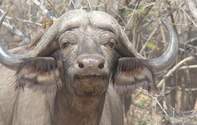
The plan to lethally dart the 70 buffalo had caused concern with managers within the neighbouring Balule Private Nature Reserve.
Although culling has a negative connotation on the surface, a deeper insight into the practice explains justifiable reasons behind the act of selectively killing wildlife. Often, culling is done to save the existing population from destruction by a few individuals that possess destructive behaviour, or to reduce the damaging effects that an oversized population might have on the vegetation of a region.
The Causes and Consequences of Culling
When a certain population of a species threatens the wellness of another population of the same or a different species, drastic measures need to be taken to ensure the greater good of the entire ecosystem. Culling is a wildlife management strategy that occurs in both protected areas as well as private game ranches.
In 2006, at least 70 buffalo were scheduled to be destroyed by state veterinary authorities on state land adjoining Balule Private Nature Reserve north of the Olifants River and south of Phalaborwa. Coming from the buffalo population of the greater Kruger National Park system, the buffalo posed a disease threat to cattle in the area as they potentially caried a variety of diseases including foot and mouth, bovine tuberculosis, corridor disease (theilerosis), and brucellosis.
In 2013, the prevalence of bovine tuberculosis had a significant impact on the Kruger's buffalo population. Buffalos have played an integral part in the transmission of the disease, due to their co-grazing with cattle. Lions, and other predators, had also been affected by the disease, mainly through the kills they made.
To Cull or Not to Cull
The buffalo are thought to have crossed the Olifants River from adjoining privately owned conservation areas and taken up residence on the state-owned farms of Doreen and Rhoda. The land is currently zoned for agricultural purposes like cattle grazing, but the Kruger National Park (KNP) has been in discussions with the department of land affairs for several years over the state farms in the area being transferred to Sanparks and reverting to conservation purposes.
The farms' close proximity to a number of Big Five reserves means that any agricultural activity in the area would be threatened by increasing levels of conflict with wildlife, and a number of lions have already been destroyed on the farms after they allegedly killed cattle belonging to the lessees of the farms.
The plan to lethally dart the 70 buffalo had caused concern with managers within the neighbouring Balule Private Nature Reserve, who said they were not consulted about the proposed cull, despite the fact that they say they have tried to proactively discuss the potential problem with provincial veterinary authorities in the past.
Balule has previously helped curtail poaching and illegal hunting on the farms, and has also discussed changing the land's agricultural status with the department of land affairs. Balule warden, Mario Cesare, says that they feel culling the buffalo is not a sustainable solution to the problem, as more buffalo will cross the river to take advantage of the grazing in the area and then more culling will be required. Cesare says that in the past they have spent in excess of R115, 000 on feed for the buffalo in an attempt to prevent them crossing the Olifants River, but the attempts were futile.
State vet Dr Dewald Keet agrees that more buffalo are likely to enter the area, but is concerned that the animals already there will follow the drainage lines north towards Phalaborwa, where they will come into contact with cattle that communal farmers allow to roam freely. This could lead to a foot and mouth outbreak similar to last year's, which cost veterinary authorities many millions to contain.
He added that an aerial survey revealed over 90 elephants on the state farms, increasing the chances of fence breakages which would allow cattle and buffalo to mingle. Until such time as the land is zoned for a land use that supports buffalo and is appropriately fenced to contain the disease threat, any buffalo that cross the river from the greater Kruger system will face the threat of being killed by animal health officials.

 African Buffalo or Cape Buffalo (Syncerus caffer). A large and powerful bovine, the African Buffalo reaches shoulder heights of up to 1.5 m ...
African Buffalo or Cape Buffalo (Syncerus caffer). A large and powerful bovine, the African Buffalo reaches shoulder heights of up to 1.5 m ...